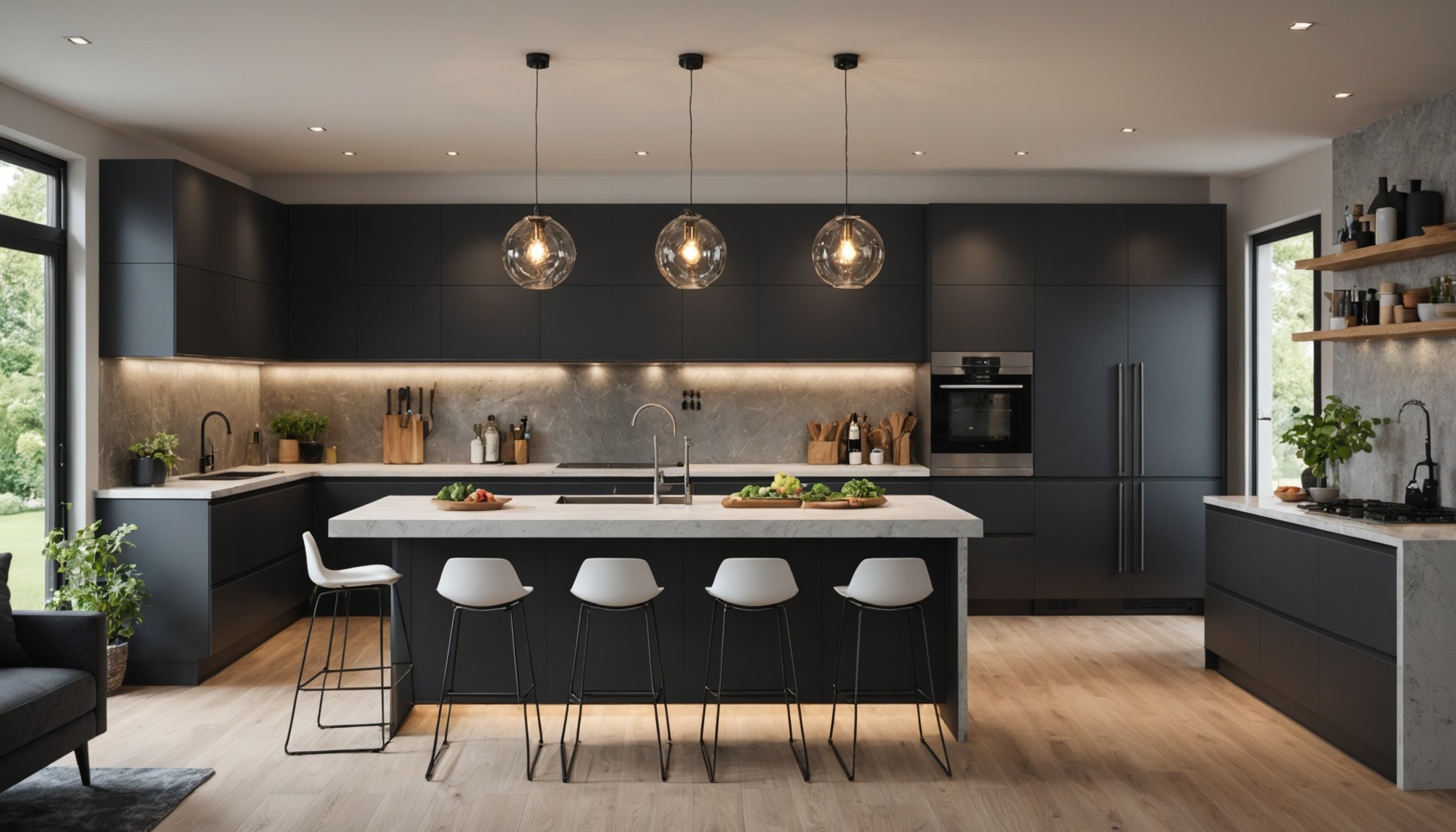Lighting can make or break a kitchen's ambiance, turning it from a functional space into a warm and inviting culinary haven. Thoughtful lighting solutions not only enhance your kitchen's aesthetics but also improve functionality, making cooking more enjoyable. Whether you're looking for bold fixtures or subtle under-cabinet lighting, explore innovative ideas that will inspire creativity and bring warmth to your kitchen. Transform your space with the right lighting approach, and watch your cooking experience come alive!
Importance of Kitchen Lighting
Understanding the transformative power of light in your culinary space.
This might interest you : Choosing the Best Kitchen Countertop Materials to Combat Bacterial Growth: A Comprehensive Guide
Enhancing Kitchen Functionality
Kitchen lighting plays a crucial role in making your space more functional. Proper lighting ensures you can safely and efficiently prepare meals. Task lighting, such as under-cabinet lights, focuses on specific areas to illuminate countertops and stovetops, reducing accidents and improving precision in cooking tasks.
Emotional Impact and Culinary Creativity
The ambiance created by kitchen lighting significantly affects mood and creativity. Soft, warm lighting can make the kitchen feel inviting, encouraging family gatherings and culinary exploration. Meanwhile, bright, cool lights can energize and motivate, fostering creativity. This emotional impact can transform cooking from a chore into a delightful experience.
Also to discover : Essential Storage Techniques for Cooking Oils: How to Keep Your Kitchen Essentials Fresh!
Ambient vs. Task Lighting
To optimize your kitchen's atmosphere, consider the balance between ambient and task lighting. Ambient lighting provides overall illumination, setting the mood for the entire space. Examples include ceiling fixtures or pendant lights. In contrast, task lighting targets specific areas, enhancing functionality.
Bullet Points:
- Ambient Lighting: Sets the overall mood, often through ceiling fixtures.
- Task Lighting: Focuses on specific areas like countertops.
- Emotional Impact: Soft lights create warmth; bright lights boost energy.
By thoughtfully integrating different lighting types, you can create a kitchen environment that enhances both functionality and emotional well-being.
Types of Kitchen Lighting Solutions
Exploring diverse lighting options to enhance your kitchen's atmosphere.
Ambient Lighting
Ambient lighting serves as the primary source of illumination in the kitchen, creating a warm and inviting atmosphere. This type often involves ceiling fixtures, such as chandeliers or recessed lights. LED lighting is a popular choice due to its energy efficiency and longevity.
Pros: Provides overall illumination and sets the mood.
Cons: May not be sufficient for detailed tasks.
Recommended Fixtures:
- LED chandeliers
- Recessed ceiling lights
Task Lighting
Task lighting focuses on specific areas, like countertops and stovetops, enhancing functionality. Under-cabinet lights are a common fixture, providing direct light where needed.
Pros: Improves precision and safety in cooking tasks.
Cons: Can create shadows if not positioned correctly.
Recommended Fixtures:
- Under-cabinet LED strips
- Adjustable track lights
Accent Lighting
Accent lighting highlights architectural features or decor elements, adding depth and interest. It often uses spotlights or wall sconces to create focal points.
Pros: Adds aesthetic appeal and highlights features.
Cons: Primarily decorative, not functional.
Recommended Fixtures:
- LED spotlights
- Wall sconces
By understanding and utilizing these kitchen lighting types, you can create a well-lit and visually pleasing culinary space.
Design Tips for Effective Kitchen Lighting
Creating a well-lit, efficient, and aesthetically pleasing kitchen space.
Layering Lighting Types
Kitchen lighting design benefits significantly from a layered approach, combining various types of lighting to achieve optimal results. Layering involves using ambient, task, and accent lighting together, each serving a unique purpose. This strategy ensures both functionality and visual appeal. For instance, while ambient lighting provides overall illumination, task lighting focuses on specific work areas, and accent lighting highlights features or decor.
Strategic Lighting Placement
Strategic lighting placement is essential to enhance kitchen workflow and efficiency. Consider positioning task lights directly above work areas such as countertops and stovetops. This reduces shadows and glare, ensuring a clear view during meal preparation. Ambient lights, like ceiling fixtures, should be evenly distributed to maintain a consistent atmosphere throughout the kitchen.
Color Temperature Considerations
Choosing the right color temperature is crucial for creating the desired ambiance in your kitchen. Warmer tones (2700K-3000K) can make the space feel cozy and inviting, perfect for family gatherings. Cooler tones (3500K-5000K) are energizing and ideal for task-oriented spaces.
Quick Tips for Kitchen Lighting:
- Layering: Combine ambient, task, and accent lighting.
- Placement: Position lights to reduce shadows.
- Color Temperature: Choose warm for coziness, cool for energy.
Implementing these kitchen lighting design tips can transform your culinary space into a functional and inviting environment.
Budget-Friendly Kitchen Lighting Ideas
Exploring affordable solutions to brighten your culinary space without breaking the bank.
Cost-Effective Lighting Fixtures
Finding affordable kitchen lighting doesn't mean compromising on style or functionality. Look for budget solutions at home improvement stores or online marketplaces. Consider fixtures like LED bulbs, which are energy-efficient and long-lasting, reducing long-term costs. Thrift stores and clearance sales can also be treasure troves for unique lighting options.
DIY Lighting Projects
Personalize your kitchen ambiance with DIY lighting projects. Creating your own fixtures can be a fun, budget-friendly way to enhance your space. For example, transform mason jars into chic pendant lights or use string lights to add a cozy glow. These projects not only save money but also allow you to tailor the lighting to your taste.
Maximizing Impact on a Budget
To maximize impact without overspending, focus on areas where lighting will make the most difference. Use a mix of ambient and task lighting to achieve a balanced look. Quick Tips:
- Prioritize key areas: Focus on countertops and dining spaces.
- Mix and match fixtures: Combine different styles for a unique look.
- Opt for dimmable options: Control the mood and save energy.
Implement these budget-friendly kitchen lighting ideas to create a stylish and functional space.
Before-and-After Transformations
Exploring the visual impact of kitchen lighting transformations through design case studies.
Inspiring Kitchen Lighting Projects
Kitchen lighting transformations can dramatically alter the atmosphere of a space, as evidenced by compelling design case studies. Consider a project where outdated fluorescent fixtures were replaced with sleek, modern LED pendants. This change not only enhanced the kitchen's visual appeal but also improved its functionality.
Analysis of Design Changes
The strategic use of ambient and task lighting can redefine a kitchen's ambiance. In one case study, installing under-cabinet lights brightened previously dim countertops, transforming the cooking experience. The addition of accent lighting highlighted architectural features, creating a focal point.
Design Elements:
- Ambient Lighting: Enhanced overall brightness
- Task Lighting: Improved workspace visibility
- Accent Lighting: Emphasized decor elements
User Testimonials
Users often express satisfaction with their kitchen lighting transformations. One homeowner noted, "Our kitchen feels more inviting and functional since the lighting update." Another remarked, "The difference in ambiance is incredible; it's like a new space."
These kitchen lighting projects demonstrate the profound impact thoughtful lighting design can have, encouraging others to explore similar upgrades for enhanced visual and functional benefits.
Practical Installation Tips and Maintenance
Guiding you through the effective setup and care of your kitchen lighting.
Step-by-Step Installation Guide
Installing kitchen lighting fixtures can enhance both the atmosphere and functionality of your space. Begin by selecting the appropriate fixture type for your needs, such as under-cabinet lights for task lighting. Turn off the power at the breaker to ensure safety. Follow the manufacturer's instructions for mounting the fixture, ensuring it is securely attached. Connect the wiring as per the guidelines, using wire nuts to secure connections. Finally, test the fixture to confirm proper installation.
Maintenance Tips for Longevity
Proper maintenance is key to extending the life of your kitchen lighting fixtures. Regularly dust and clean fixtures to maintain brightness and efficiency. Replace any burnt-out bulbs promptly to avoid uneven lighting. For LED lights, ensure they are installed in well-ventilated areas to prevent overheating.
Safety Considerations
Working with electrical fixtures requires careful attention to safety. Always cut the power supply before beginning any installation or maintenance tasks. Use insulated tools and wear rubber-soled shoes to reduce the risk of electric shock. If unsure, consult a professional electrician.
Quick Tips for Safety:
- Turn off power before installation
- Use insulated tools
- Consult professionals if needed
These practical tips ensure your kitchen lighting installation is safe, efficient, and long-lasting.













